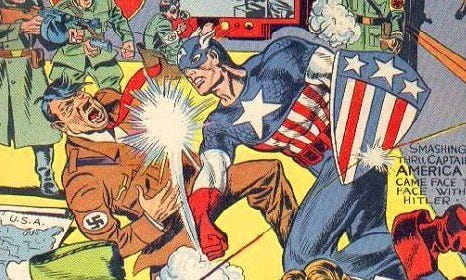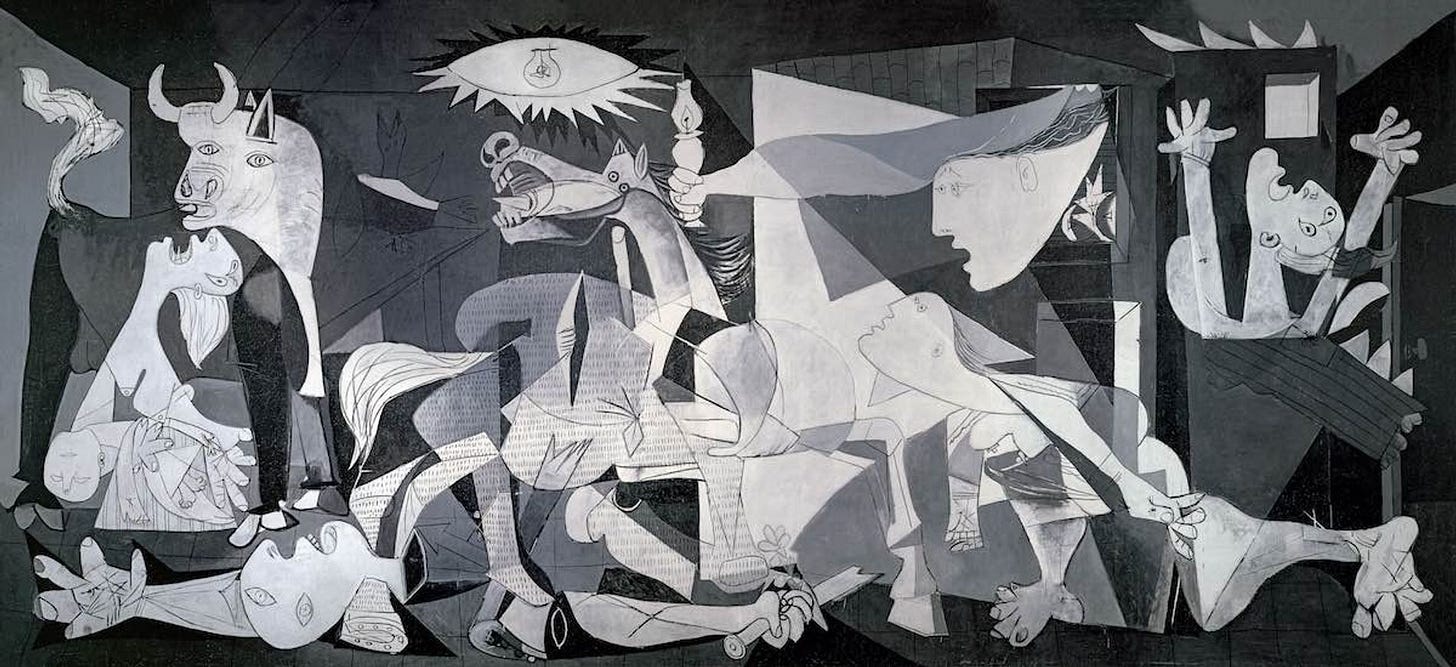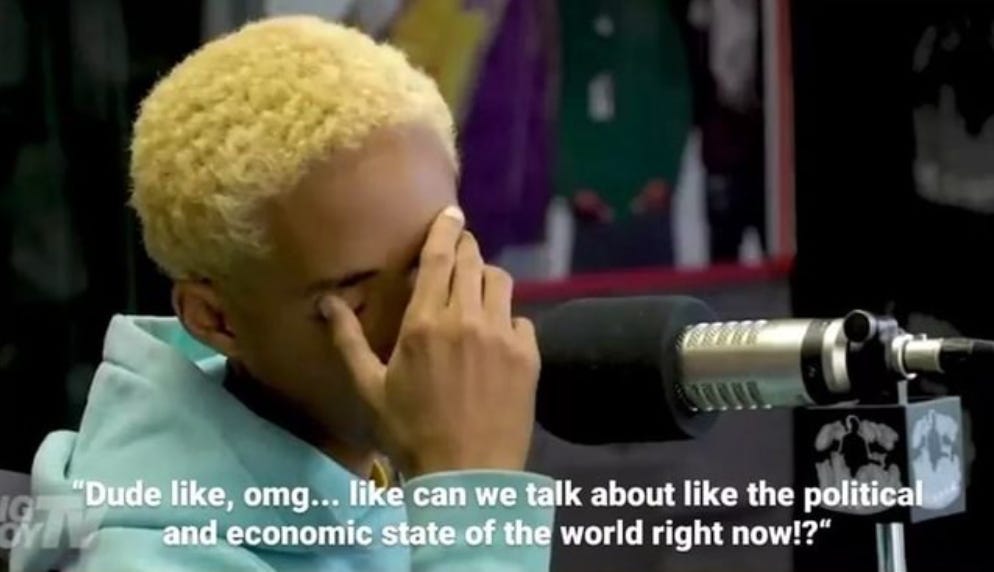art in the face of adversity
art and politics: how does art serve humanity, and vice versa?
I’ve been feeling worried lately. About the world. About my place in the world. About everything.1 And I’m sure I’m not the only one who feels like this, like hopelessness has become our norm.
During times like these, I find myself referring back to Picasso’s Guernica. I’m not usually a fan of his work, but this painting is especially moving to me. I think because it’s very direct with its message—the intense suffering depicted. You can’t really look away.
Apparently I’m not the only one who thinks that way—it’s one of the most famous anti-war paintings after all. It’s Picasso’s interpretation of the horrors of war.
Art should always be considered in its context, because it is a product of its environment, and our environment is, inevitably, political. Art and/or the artist cannot ever be apolitical. The act of creating instead of consuming in itself is a political act. It’s rebellious, it’s an active choice.2 The horrible context of Guernica is very famous and linked to the painting, which is probably why it’s so moving to the general audience. When we look at it we don’t just see a war, we see the war, the remnants of it—it’s real. Right there, in the painting. When I was little I thought Guernica meant ‘war’ in Spanish.
Yes, everything is political, even things you watch to escape the reality of our exhaustingly political world. The morning routine video of that ‘alpha male’ guy that’s going around is political. The scenes he chooses are very intentional; a worker giving him a towel when he gets out of the pool, a faceless girlfriend/ wife preparing his meal and bringing it to his table. Nara Smith’s simple cooking videos are political. The voice she uses, the clothes she wears, what parts of her life and her relationship she shows to the world, and what parts she doesn’t.
What you get out of this content depends on how you take it of course. You can either watch it as it is and move on, or you can read between the lines.
I think people forget this sometimes, that you’re supposed to take away something from what you’re consuming. Whenever someone says movies are political, for some reason without exception the first counter-argument is always that Marvel movies are not political, they’re for entertainment purposes only! Sure, I don’t think a movie about a guy named Captain America fighting Nazis has a political stance. How do you watch a movie titled Captain America: Civil War and still think it’s not political? Besides, comic books are widely known to have a lot of political and social commentary embedded in their stories, and superheroes are, more often than not, propaganda tools. It makes me sad to think that there are people out there who believe these movies, these characters and their stories are not telling you something.

But can a simple painting, or a fictional character really make a difference in face of war? And why do we, as humans, feel drawn to create something when faced with suffering?
History is the most important tool at our disposal for making sense of our present. Just like fashion trends that are bound to come back every 20 years, we are bound to repeat our mistakes every however many years it takes. It’s human nature I guess. And the difference between art and history is that human emotion is at the center of art, it’s what drives it. History might seem exclusive to those who particularly enjoy it, it might feel out of reach for the common people—too formal, too academic. But art is for the people.
Difficult times like war, famine, political protests have historically shaped our cultures, as a shared experience, and a shared suffering; one that ignites change. As art feeds and grows on culture, artists have always been at the forefront of the change it brings. Because it is through art that ideas—revolutionary, groundbreaking, and controversial ideas—reach and unite the people.
Whether it’s intentional or not, we week solace in the arts. It has the ability to convey the experiences of those who suffer, marginalized groups of people that maybe we’re not a part of, through adversities we wouldn’t have been able to imagine. It’s an important medium for social commentary. It thrives on empathy and understanding for others, and that’s why it’s a tool not only for education but also for inspiration.
Like I said, art is much more meaningful when considered in its context, and it also helps shape and visualize our context. It’s a window through time. Let’s take movies for example; if we looked at all the Best Picture nominees of last year, the films that were globally recognized as ‘the best’, what would be the prevailing and common themes? I would say immoral and greedy men in power abusing their positions3, and the dangers of xenophobic beliefs4. There is a reason this list of movies exploring these themes were chosen that year. This is media that we all collectively consumed, therefore it has become part of our culture.
We resonated with these movies the most because that’s what we’re going through right now, we can relate to them. The directors of these movies made them because that’s what they’re going through right now. They’re commenting on the world through their art. Their movies will be the context of our times.
It would have been easier for Picasso to do nothing after the war, but he chose to do something, he chose to tell the story of his people and their suffering. Maybe his painting is why we still talk about it today. It would have been easier for Joe Simon and Jack Kirby to not create a superhero who punched Nazis in the face, but they did, and even got death threats over it. It doesn’t seem that controversial in today’s climate, but it was very much so at the time. The image that the US has established for itself as a Nazi-hating country, was probably in part thanks to Captain America.5
Our words, our feelings, and our art has the power to change and shape the world. And they have, for centuries before now. So watch as many movies, read as many books and learn about as many paintings as you can. Watch films that are fun, but also watch films that are hard to digest, that make you uncomfortable and make you think differently, and learn something from them.
When I feel hopeless, when I need motivation, when I need to understand, I will continue to turn to art, and I will continue to learn from it, because art is the highest form of hope. If and when you choose to direct your critical lens to what you consume, you’ll find an abundance of messages in everything. Everything is telling you something, but only if you’re willing to listen. Picasso wants you to take something from his paintings, from Guernica, as he said with his words,
We all know that art is not truth. Art is a lie that makes us realize truth, at least the truth that is given us to understand.
love, asli
which is also one of the reasons why AI can’t make art actually
Dune, Conclave, The Substance, The Brutalist, Anora, I’m Still Here
Wicked, Conclave, Nickel Boys, The Brutalist
of course, i don’t agree with a lot of captain america’s political views as portrayed in the comics since then. he is a clear representative of the patriotic and conservative american (yikes). after he had no more nazis to punch, he became known as the ‘commie smasher’.







Thank you. I was considering going to an art gallery today, and now I definitely am. 😊
“Art is the highest form of hope.” I love this.